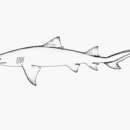Diagnostic Description
(
anglais
)
fourni par Fishbase
A brownish shark with yellow overtones but no conspicuous markings. Large second dorsal fin nearly same size as first dorsal (Ref. 26938).
- licence
- cc-by-nc
- droit d’auteur
- FishBase
- Recorder
- Grace Tolentino Pablico
Life Cycle
(
anglais
)
fourni par Fishbase
Distinct pairing with embrace (Ref. 205). Viviparous, placental (Ref. 50449), with 5 to 17 embryos (Ref. 9253). Both male and female during precopulatory and courtship swim with body axes in parallel (Ref. 49562, 51112). During copulation, the pair performs coordinated swimming (Ref. 49562, 51112).
- licence
- cc-by-nc
- droit d’auteur
- FishBase
Migration
(
anglais
)
fourni par Fishbase
Oceanodromous. Migrating within oceans typically between spawning and different feeding areas, as tunas do. Migrations should be cyclical and predictable and cover more than 100 km.
- licence
- cc-by-nc
- droit d’auteur
- FishBase
- Recorder
- Kent E. Carpenter
Trophic Strategy
(
anglais
)
fourni par Fishbase
Exhibits no pattern of periodicity. Feeding is asynchronous and intermittent. Daily ration is estimated at 1.5 - 2.1% body weight per day; meal completely evacuated from stomach 25-41 hr after feeding, depending on meal type and temperature; fecal production continues for 68-82 hr after feeding (Wetherbee 1990).
- licence
- cc-by-nc
- droit d’auteur
- FishBase
Biology
(
anglais
)
fourni par Fishbase
Occurs on continental and insular shelves, frequenting mangrove fringes, coral keys, docks, sand or coral mud bottoms, saline creeks, enclosed bays or sounds, and river mouths. May enter fresh water. Occasionally moves into the open ocean, near or at the surface, apparently for purposes of migration. May rest motionless on the bottom (Ref. 9710). May occur singly or in small groups. Feeds mainly on fish but also takes crustaceans and mollusks. Viviparous, with 4 to 17 young in a litter. Size at birth 60 to 65 cm. Has been involved in several attacks on people. Meat is utilized for human consumption, hides for leather, fins for shark-fin soup base, liver oil for vitamins, and carcasses for fish meal. Marketed fresh, dried-salted and frozen (Ref. 9987).
- licence
- cc-by-nc
- droit d’auteur
- FishBase
- Recorder
- Kent E. Carpenter
Importance
(
anglais
)
fourni par Fishbase
fisheries: commercial; gamefish: yes
- licence
- cc-by-nc
- droit d’auteur
- FishBase
- Recorder
- Kent E. Carpenter

